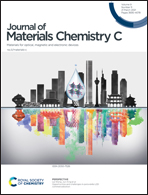Heterogeneous post-passivation of inorganic cesium lead halide perovskite quantum dots for efficient electroluminescent devices†
Abstract
A heterogeneous post-passivation process has been demonstrated by using formamidinium bromide (FABr) to compensate the surface bromo vacancy of inorganic cesium lead halide perovskite quantum dots (QDs). Benefitting from its limited solubility, the passivation is anticipated to happen in a two-phase heterogeneous mixture, and excess FABr can be easily removed using a polytetrafluoroethylene (PTFE) syringe filter before device fabrication. This is quite different from didodecyldimethylammonium bromide (DDAB)-based homogeneous post-passivation, where a large amount of DDAB residue is still left in the spin-coated film. Consequently, a more favorable electrical behavior is observed in FABr passivation compared to that in the DDAB one, although they both show comparable improved photoluminescence quantum yields due to bromo compensation. The corresponding perovskite quantum dots light-emitting diodes with FABr-treated green-emitting CsPbBr3 QDs achieve a promising external quantum efficiency (EQE) of 7.94% and luminance of 14 790 cd m−2, much higher than those of the pristine (1.78%, 4640 cd m−2) and the DDAB-treated samples (3.91%, 167 cd m−2). This methodology is also suitable for the surface defect passivation of blue-emitting CsPbBr1.3Cl1.7 and red-emitting CsPbBr1I2 QDs. The results clearly highlight that heterogeneous post-passivation can boost the photoluminescence and electroluminescence performance of inorganic cesium lead halide perovskite QDs simultaneously.



 Please wait while we load your content...
Please wait while we load your content...